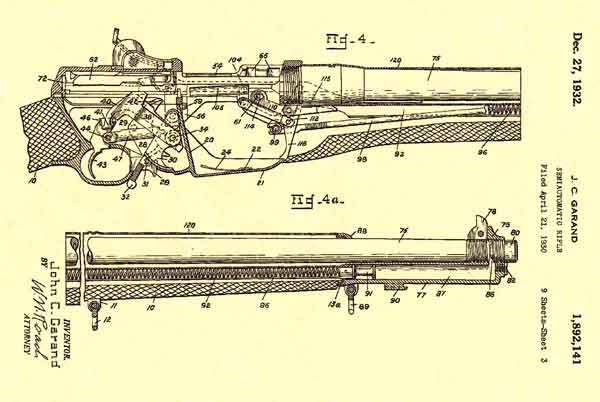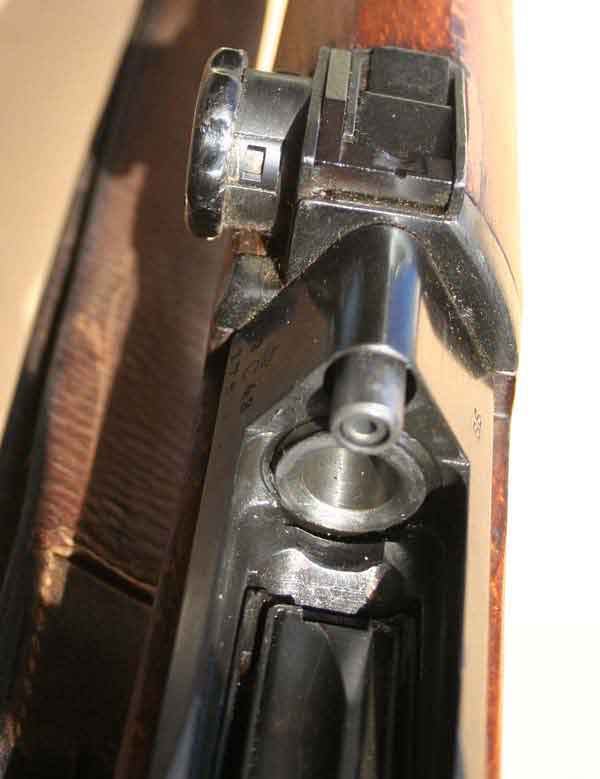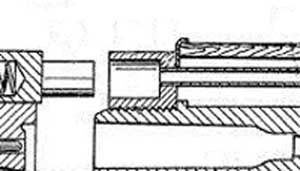
| Military Rifles
1894-1960 |
|
Military Semi-auto rifle Ag m/1942 |
|
Military & FSR
Rifles 1960-2019 |
|
Military Rifles 1990-2019 |
|
Ag 90 (Barrett 82A1) |
Text and pictures by O. Janson
Uppdaterad 2019-04-18
 |
|
Above the early Swedish Semi-automatic rifle Ag m/1942 |
 |
|
Above is Ag m/1942B. |
|
Around 1890 several famous men like Hiriam Maxim, John Moses Browning, Von Mannlicher had brought out ideas for so called automatic rifles. An automatic rifle is actually a self loading rifle. In appearance, general design, size and weight it looks like an ordinary military manually repeating rifle. However the military worldwide was not really interested in self loading rifles. They were happy with their bolt rifles, which were strong and reliable. The military considered at that time negative to use firepower by plenty of shots. They wanted the soldiers to spare their ammunition. During the Great War there were some attempts to introduce these self loading rifles made by France and Russia. |
|
|
At the end of the war there was
however great a demand among the soldiers at the front for semi- or full
automatic rifles. A very
popular gun was the
Winchester M1907 which was purchased privately.
Winchester M1907, with an extended magazine for the war in France. |

|
The only military accepted automatic rifle which was used successfully during the Great War was the US BAR, constructed by John Moses Browning. However it was quite heavy. |
|
Between the wars both USA
and the Soviet Union accepted semi-automatic rifles. USA accepted 1936 John Garands semi-automatic rifle. He applied for patent for it already on the 21st of April 1930 |
 |
John Garands
semi-automatic rifle.
Here is one of the patent drawings
|

|
|
|
The Soviet Union and the Red Army made several tests between 1931 and 1936. Sergey Simonov brought out an automatic rifle which was adopted as Model 1936 or AVS-36 in short. Service life of this weapon was relatively short, as it was too complicated and not sufficiently reliable in harsh conditions. In 1938 the SVT-38 (Samozaryadnaya Vintovka Tokareva - Tokarev Self-loading rifle) was adopted. It was designed by Fedor Tokarev. 1940 it was improved and adopted as SVT-40. More than 1 million rifles were made prior to 1945. |
|
|
| Here is a Tokarev SVT-40 |
|
Many enemy troops
like the
Finnish and German considered it to be very good,
while it has low reputation among Russians. The truth is the matter of training
and education. The majority of the Red Army lacked the proper education and
training for this nice rifle. They were not capable of taking it apart properly
and keeping clean. They preferred the standard Mosin-Nagant bolt action instead. The interesting feature of the SVT is that the gas block, along with front sight base and a muzzle brake, was produced as a single barrel extension unit. This enhances the capacity for precision shots. The construction simplified the manufacture of the barrel, but the barrel extension itself unit was quite complicated to make. |
 |
|
Test model FM 40 WBG
Eric Wallberg tried to change already existing bolt action of the Swedish rifle m/39 (Kar 98k) to semi-automatic (Picture taken at Vapenmuseet in Eskilstuna.) |
The beginning.In Sweden the interest for a semi-automatic rifle started around 1938. To start with Eric Wallberg at KATF (Kungliga Armétygförvaltningen, Stockholm) tried to change already existing bolt action rifles to semi-automatic. Very soon it was clear that a completely new construction was needed. An offer went out to constructors. Several guns were tested. They can be seen on the picture.
An interesting
construction was made by the Finnish Captain Pelo. |
 |
| One of the weapons from Captain Pelo from Finland. |
|
Here is a picture of different test weapons used to develop semi-automatic rifles. I took the photo in Vapenmuseet, Eskilstuna while it still was available to the public. Unfortunately it is closed now.
Click on the picture to make it larger. (260 Kb) |
Ag m/42 (Ag = Automatic Rifle)
Development The winner of this contest was a construction made by manager Erik Eklund at AB J.C. Ljungmans engineering company (LME) in Malmo. The first meeting about this rifle was held 25th of August 1941 and the semi-automatic rifle was accepted on the 5th of December 1941. It was also here the test rifles were built. This company normally produced pumps for petroleum. The construction has borrowed some ideas from the Tokarev SVT-38. The Swedish gas system is inferior to the Russian because the gas tube and the barrel are locked together and when the barrel becomes warm it can note move properly because of the gas tube. The influence on dispersion of heating of the barrel during continuous firing wary from best results 83 mm at 100 m to the worst case with 356 mm at 100 m! The SVT-38 and 40 don’t have this problem because of the muzzle attachment with the gas chamber. The semi-automatic rifle was called Automatic Rifle m/42 (Ag m/42) and it was introduced to the Swedish Army less than one year after having left the drawing board, extraordinary by any standards. The manufacturing of Ag m/42 took part in Eskilstuna at Carl Gustaf’s gun factory during basically only 1943. All together 30 000 Ag m/42 were made. The instruction manual was first issued to the military separately but from 1943 edition of Instruction for the soldier this manual was included. The manual remained as part of this Instruction for the soldier until 1970.
The "Problem Child" Ag m/42 There were plenty of problems with the Swedish semiautomatic rifle Ag m/42. It caused them many problems, even to the degree it was called the “Problem child” or the “Black Sheep”. One of the major problems was the extractor which broke off too often. Engineer Elias Hermelin, was for many years manager of the lab in Carl Gustaf Gunfactory. He wrote following about Ag m/42: Considering the delivery of material autumn 1941 (according to the suppliers recommendation) there is a change between the material and the heat treatment which demands a reconstruction. 28th of April 1942 - material ordered according to suppliers recommendation change of heat treatment in order to try to save from the beginning the unsuitable material.
1st of April 1943 broken extractor after hardly 4.000 rounds fired, which caused another change of heat treatment. In middle of April the new treatment has been applied for the first 50 guns. 13.400 rounds have been fired without malfunction. 30th of April 1943 – 22.900 rounds fired. During the early summer 1943 changes in the heat treatment between GF and LME. 1st of September 1943 – 8 extractors were found broken. 14.000 extractor were delivered – extensive material testing for hardness was made. Limit for scraping was decided by shooting.
In the beginning of September 1943 it was found out that LME had delivered
extractors with changes in the hardness index. The steel from Fagerstad Steel
had a great variations of carbon from 0.15 – 0.40%. September 1943 – New tests showed good results. New material with C= 0.70% have been delivered to LME. The older material with C= 0.20% should be used for other parts in the work. 16th November 1943 – First delivery from LME of extractors in the new material didn’t arrive to Gun Factory until 17th of April 1944. ---- There were other problems also. The rifles were stowed away in storages and covered with grease. The gas tubes were made of ordinary steel. Gun grease is hydroscopic and collected water, which caused the tubes to rust. This was changed to stainless tubes later. The magazine fell out by mistake sometimes. This was later corrected. A major refurbish of all Ag m/42 was made in the early 1950s. The result became Ag m/42B. Once apon a time the “Problem Child” had become a rather good service rifle which was used until it was relieved by the assault rifle AK4 (German G3) 1965. The army had the false idea that AK4 should be used instead of Ag m/42 and the submachine gun Kpist m/1945B. Nowadays the Army reconsider their ideas. |
 |
|
Above is one of the rare remaining original Ag m/1942 |
 |
 |
|
original Ag m/1942 (Armymuseum) |
Function:The basic feature of the Ljungman Ag m/42 system was unusual, when first introduced, although it has since become more widespread: The usual gas piston assembly has been discarded in favour of a simple direct gas construction, where the gases themselves impinge upon the bolt. There is no gas piston nor any rod device at all used to convert the gas pressure into mechanical action! This direct-gas system has since been used with success on Stoners AR10 and AR15 rifles. When the bullet passes the hole in the top of the barrel, a small amount of gases are returning backwards through a gas tube. There is a small cup fixed to the carrier of the bolt surrounding the gas tube. When the gases come backward they hit this cup and force the bolt carrier backwards and the bolt is lifted up from its locked place.
|
 |
The rear end of the gas tube comes out above the chamber |
 |
The rear end of the gas tube meeting the cup on the bolt-carrier. |
 |
The rear end of the gas tube meeting the cup on the bolt-carrier. Closed action. |
|
The rear end of the gas tube meeting the cup on the bolt-carrier. Opening
action. Note that there is not any gasket but the steel cup itself. |
 |
 |
|
The
simple direct gas construction, where the gases themselves impinge upon the
bolt. |
|
The ammunition used
by the military from 1894 was a cartridge called m/94 with a 10,1 gram (157
grain) round nose bullet. Since many years before WW2 ammunition manufacturers
in Sweden had made torpedo ammunition with a 9 gram (140 grain) bullet for the
civilian Sharpshooter association. This torpedo bullet had much better
ballistics then the round nose bullet. 1941 the defence forces accepted this bullet and it was called prj m/41. The rear sights of Ag m/42 had a small picture of either round nose or torpedo to show the soldier how to make his sight according to what ammunition he used. (See the picture below.) |
|
|
The rear adjustable sight At the arrow you can see the mark for the torpedo bullet prj m/41. |
|
|
The different cartridges in the Swedish 6,5x55 mm in the army manual 1960. At top of the page it says which weapons can be used with these 6,5x55 cartridges: Carbine m/94, Rifles m/96, m/38, m/41(B); ag m/42 B, kg m/21 and m/37; Machineguns m/14-29, m/36 (ground, AA and tank), m/39 (tank) and m/58.
You can clearly see the bullets:
(prj shortening of projectile) |
Improvements.Major Karl-Olof Björsell (retired) has told me an episode from spring 1951 when his company started to shoot for the first 2-3 shots the guns refused to reload properly. Rust coloured oil came out of the gas tube instead. After these shoots the rifles worked fine. I remember myself that the first time I shot with an Ag m/42B, during my time at the High school, how I was amazed by the puff of air I got over my head for each shot. From the beginning the gas tube was made of steel which rusted. The soldiers found it easy to drop the magazines by mistake The cleaning rods were from the beginning made of a tube with inner steel rod which should be screwed together to make full length so they could reach all the way. The construction was too weak. The cover for the bolt carrier, which was used for loading and discharging of the gun, was only serrated. With cold and numb fingers this serration was too little. If you consider the very haste with which the Ag m/42 was adopted it is not strange that there was a need for modifications and they were:
These improvements were accepted 1953. During the first part of 1950:s all the Ag m/42 was improved. This was done so very well that you most likely will never find any original Ag m/42 which has not been improved. They are extremely rare. The improved rifle was called Automatic rifle m/42 B.
|
|
|
|
The cover for the bolt carrier on Ag m/42 first model. |
|
|
|
The cover for
the bolt carrier on Ag m/42 B. |
|
|
 |
|
Ag m/42 magazine (first model) |
Ag m/42B magazine - second model with extra hooks. |
|
|||||||||||||||||||||||||||||||||||
Continue reading about Ag m/42B part 2
|
References: Karl-Olof Björsell, Gothia Arms Historical Society annual magazine No 14, 1995 Claes-Goran Roos, EVhS Instruction manuals for the Swedish army 1939 to 1983. Josef Alm, Arméns eldhandvapen förr och nu, 1953 Vapenmuseet, Eskilstuna Sweden Joseph E. Smith and W.H.B. Smith 10th Edition of Small arms of the World 1973, ISBN: 0-89104-021-8 Ian Hogg & John Weeks, Military small arms of the 20th century, 1973, SBN 85368 319 0
|
| Military Rifles
1894-1960 |
|
Military Semi-auto rifle Ag m/1942 |
|
Military & FSR
Rifles 1960-2019 |
|
Military Rifles 1990-2019 |
|
Ag 90 (Barrett 82A1) |